Peste Des Petits Ruminants (PPR) in goats is a highly contagious, fast-spreading, killer disease of small domestic ruminants, primarily sheep and goats. The disease was first reported in Ivory Coast, a West African country, in 1942. Since then, the disease spread to the Near East and Arabian Peninsula, central countries of the Middle East and South Asia, and India, Pakistan, Nepal, Srilanka, and Bangladesh.
The disease is more severe in goats than sheep, with a case fatality rate of 55-80% and 10%, respectively. In the endemic areas, the morbidity rate of PPR in goats has reached around 100%, with a mortality rate of about 80%.
Importance of PPR in Goats As A Disease
Small ruminants, mainly sheep and goats, comprise more than 2.5 billion throughout the world. The villagers and poor people mainly rear these animals. The small ruminants are one of the primary income sources of marginal people. The disease PPR affects the animals and causes substantial economic losses to these poor farmers. The knowledge on PPR will help to effective prevention and control of the disease in a rural area. In my article, I shall discuss the most critical points on this economic disease.

Causes of PPR in Goats
PPR virus is the causal agent of the disease under genus Morbillivirus, family Paramyxoviridae. The virus is very similar to the Canine Distemper and Rinderpest virus of Cattle. The disease is highly pathogenic and spread very rapidly to susceptible hosts. The other name of the disease is “Goat Plague” or “Ovine Rinderpest.”

Transmission of the PPR Virus
The disease’s incubation period is 4-5 days after injection of the organism in a susceptible host. The excretion and secretion of the affected animals are the sources of infection. The virus is transmitted and spread by direct and indirect contact with the infected animals. The movement of affected animals primarily spreads the disease to non affected areas during any festivals. The virus may spread by:
- Nasal Discharge.
- Coughing.
- Faces of infected animals.
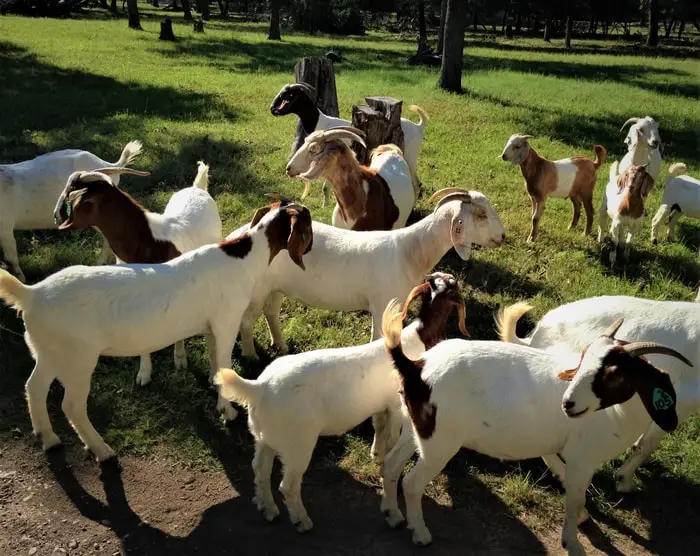
Host of PPR Virus
The sheep and goat, small ruminants, are the primary hosts of the PPR virus. The white-tailed deer, oryx, and Gazelle are also susceptible to this virus. Large ruminants like cattle, buffalo, and pigs can be infected experimentally, but they are the dead-end hosts. Large ruminants do not exhibit any clinical signs, and they do not spread to other animals.
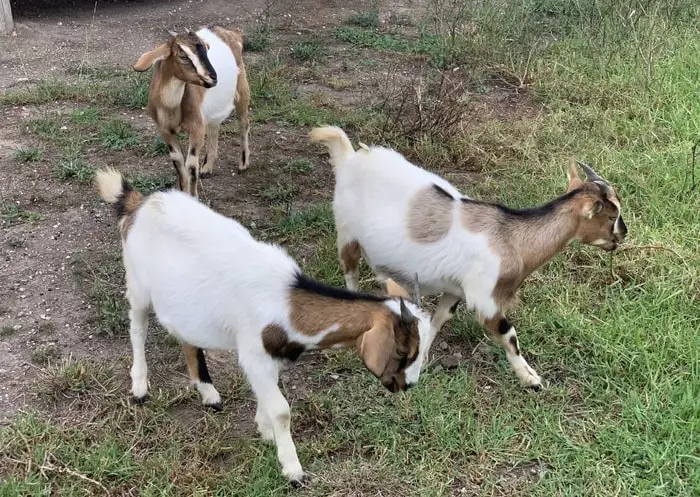
Pathogenesis of PPR in Goats
The pathogenesis of the disease are as follows:
- PPR virus is excreated in all the excretions and secretions of infected animals and is disseminated by aerosol.
- The virus penetrates the retropharyngeal mucosa, where they first replicate and then spread to local lymphatic tissue.
- They then replicate in local lymph nodes causing primary viremia.
- The virus then spread to other lymphoid tissues and organs involving skin, kidney, gastrointestinal tract (GIT) and causes secondary viremia.
What are the symptoms of PPR?
The disease’s incubation period is usually 3-5 days, and young goats may die before developing any clinical signs. The usual clinical signs and symptoms are:
- There is a presence of a high fever (105° to 107° F).
- Marked depression.
- Sleeplessness.
- Anorexia.
- Clear watery discharge from the nose, eyes, and mouth later become thick and yellow.
- The discharge tends to dry, causing matting together of the eyelids, obturation of the nose, and difficulty breathing.
- Erosion and ulceration in the mucous membranes lining the mouth, the gums, dental pad, palate, lips, cheeks, and tongue may also involve the nose and the genital organs.
- Watery, foul-smelling diarrhea is sometimes mixed with blood and pieces of dead gut tissues.
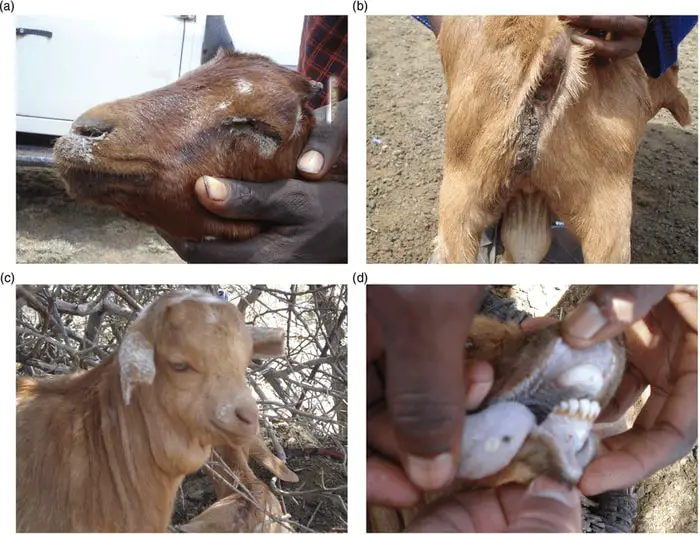
- Pneumonia and there may be coughing.
- Secondary infections follow due to loss of general immunity.
- The animal may die within 4-10 days in untreated cases.
- In sheep, the disease occurs most commonly in sub-acute form with less marked signs and symptoms.
- Abortion in pregnant animals.
- The death rate is higher in young animals.
Pathological Lesions of Goat Plague
The usual pathological lesions of the disease are:
- The carcass is usually emaciated, dehydrated, and the hindquarters soiled with soft, watery feces and the eyeballs sunken.
- The eyes and nose contain dried-up or mucopurulent discharges.
- There are erosion and ulceration in the lips, gums, cheeks, soft and hard palates, tongue, throat, and esophagus.
- The lungs have dark red or purple areas, firm to touch, mainly in the anterior and cardiac lobes with the trachea and bronchus containing frothy exudates.
- Lymph nodes associated with the lungs are soft and swollen.
- Abomasum, small, and large intestine may have congested lining and bleeding.
- Characteristics linear hemorrhage followed by dark or black streaks called “Zebra Stripes” in the caeca-colic junction and colon.
- Petechial hemorrhage may be found in the trachea, larynx, and turbinates.
- Bronchopneumonia patches may be found.
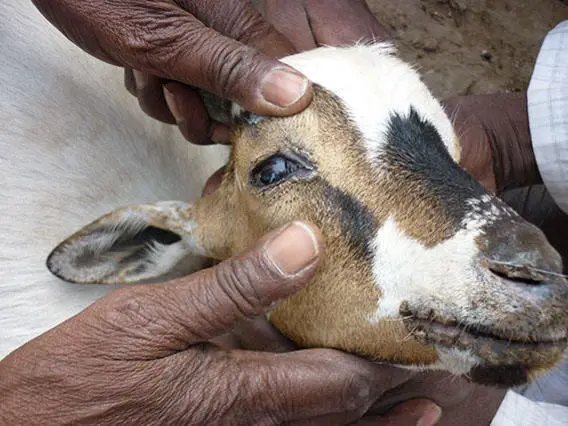
Diagnosis of PPR in Goats
The diagnostic procedure of Peste Des Petis De Ruminants are as follows:
- The initial diagnosis is made by the history, epidemiological data, clinical signs, and pathological lesions.
- The confirmatory diagnosis is made by the isolation and identification of causal virus from the infected animal.
- The confirmatory diagnosis is made by:
- ELISA.
- RT-PCR.
- Agar-gel immunodiffusion test (AGID).
- Virus neutralization test.
- Indirect immunofluorescence Assay (IIFA).
- AGID is widely used in developing countries to identify and report disease.
- Virus isolation is time-consuming and requires more time.
- ELISA and Virus Neutralization test is OIE recommended test for this disease.
Differential Diagnosis of Goat Plague
- The mouth lesions should be differentiated from Rinderpest, Foot and Mouth Disease (FMD), Blue Tongue, and Contagious Ecthyma.
- Nasal discharge and difficulty breathing may be confused with Pneumonic Pasteurellosis and Contagious Caprine Pleuropneumonia (CCPP).
- Diarrhea may be confused with Coccidiosia, Colibacillosis, Gastrointestinal helminth infestations.
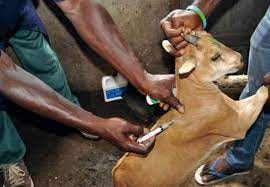
How do you treat PPR in goats?
PPR is a viral disease and very difficult to treat the disease. The routine treatment procedures are as follows:
- There is no actual treatment of this disease.
- Treatment of the disease should be given symptomatically to prevent secondary infection.
- Long-acting antibiotics can be given to treat PPR.
- For diarrhea, sufficient oral saline and gut-active sulfonamides you can give.
- Treatment with immune serum from recovered animal or vaccinated goats and a suitable antibiotic has been found to have a dramatic effect in curing the diseased animals.
Prevention and Control of PPR
The disease of goat spread very rapidly, and the morbidity rate is very high. You can prevent the disease in your herd by taking few preventive measures:
- Disease surveillance, monitoring, and reporting.
- Rapid diagnosis of PPR.
- Isolation of affected goats from healthy ones.
- Avoiding transfer of affected goats to the grazing fields, markets, or other places.
- Imposing movement control in the outbreak area.
- Disposing of the dead goats and the feces and urine of the affected goats by burning or burial after treating a suitable disinfectant.
- Quarantine and vaccination of the new goats before introducing them in the herd.
- Ring vaccination of the healthy goats around the affected area.
- Mass vaccination.
Concluding Remarks on PPR in Goats
PPR is a highly contagious and severe viral disease of sheep and goats. The disease causes enormous economic losses to the poor farmers by the death of their valuable domestic animals. The disease spread very rapidly and causes maximum death to young animals. The disease can be prevented by mass vaccination and isolation of sick animals at the very initial stage.